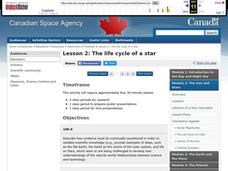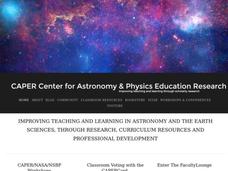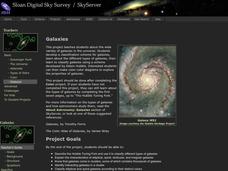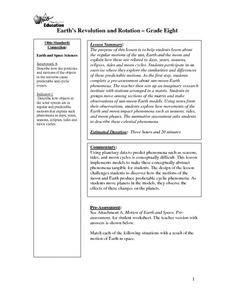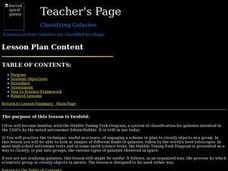Curated OER
Tracking and Tracing Sunspots
Learners examine sunspots. In this sunspot lesson, students use applets to investigate the movement of sunspots. Learners research sunspots and evaluate the rotation of the sun. Lesson references outside resources not available in this...
Curated OER
Hunting for galaxies in the Hubble Deep Field
Learners examine Hubble Deep Field images. In this galaxy classification lesson, students research galaxy classification. Learners view and classify Hubble Deep field images of galaxies.
Curated OER
How Hot is that Star?: Astronomy, Sun, Solar Temperature, Science
Students explain sun facts and solar information. They discover how temperature of a star is measured. They investigate the various scales used to measure temperature. They observe images of the sun. They classify stars according to te
Curated OER
Planet Picking
Middle schoolers arrange the planets according to their distances from the sun. In this astronomy lesson, students list interesting properties about each planet. They identify an unknown planet photo.
Curated OER
Lesson Plan on Kepler's Laws of Planetary Motion
Students construct a solar system model. In this space science lesson, students calculate the eccentricity of a planet's orbit. They calculate the period of a planet's revolution using Kepler's formula.
Curated OER
Edible Model of the Sun
Students identify the different features of the Sun. In this space science lesson, students create a model of its surface using cookies and candies. They compare and contrast their model to the real Sun.
Curated OER
#24 Rotating Frames of Reference in Space and on Earth
Students explore rotating frames of reference, focusing on the weightless environment in space and the Coriolis force.
Curated OER
The KAO Telescope
Students explore the basic principles of the operation of the NASA's KAO telescope. They construct a simplified model of it using film canisters and other everyday objects. Step by step directions are included in plan.
Curated OER
Spaced Out
Students explore the transit of Venus and the information that this minieclipse provides about the distance between the Earth and the sun. They create their own astronomical units.
Curated OER
Distances to Stars
Students explore the idea of parallax. In this astronomy lesson, students study the distances of stars. They investigate how parallax can be used to determine these distances.
Curated OER
The Life Cycle of a Star
Students investigate the life cycle of a star and make conclusions based on evidence, research, and observation. In this lesson on space and scientific investigation, students describe the relationships between science and technology...
Curated OER
Observing and Sketching the Lunar Surface
Students explore space science by conducting an illustration activity. For this lunar lesson, students discuss what the moon is and the role it plays for our environment on Earth. Students view images of the moon and utilize chalk to...
Curated OER
Making Regolith
You may not be able to take a field trip to the moon, but that doesn't mean your class can't study moon rocks. Using graham crackers as the moon's bedrock and powdered donuts as micrometeorites, young scientists simulate the creation of...
Curated OER
`Great Debate' Lesson Plan for Undergraduates
Students study the Curtis- Shapley debate which highlighted the view of human place in the universe. They examine the clash of these two astronomers in a debate which took place in 1920.
Curated OER
The Expanding Universe
Students explore the expanding universe. In this science lesson, students use balloons to model the expansion of the universe. Students take measurements of the balloon expansion and answer questions directed to develop their...
Curated OER
Momentum
Students learn the concepts of momentum and its conservation, using the recoil of a cannon as an example. They examine how momentum is a vector, allowing its conservation to be applied to problems in 2 and 3 dimensions.
Curated OER
Galaxies
Students use the provided website to classify galaxies after exploring information about elliptical, spiral, lenticular, and irregular galaxies and using the Hubble Tuning Fork.
Curated OER
Lunar Language
Students use a Lunar Language Graphic Organizer to draw and describe the phases of the moon. They explain patterns of changes in the appearance of the moon as it orbits Earth.
Curated OER
Earth's Revolution and Rotation
Eighth graders investigate the regular motions of the sun, Earth and the moon and explain how these are related to days, years, seasons, eclipses, tides and moon cycles. They participate in an exercise where they explore the...
Curated OER
Puzzling Planets
Students examine the concept of a solar system. In this research based lesson, students compare a star and a planet. They explain the requirements for life in a biosphere.
Curated OER
Charting The Planets
Young scholars conduct different activities in order to unlock the secrets of the universe. They answer different questions that are written to assess knowledge of the planets. Information can be found on the internet to help.
Curated OER
Classifying Galaxies
Students classify galaxies by their shape using the Hubble Tuning Fork Diagram.
Curated OER
Stellar Lunar Curriculum
Students engage in a lesson that covers the concept of different phases of the moon. They name the cycles of the phases of the moon while using flashlights to simulate the light of the sun. They research information about several...
Curated OER
Why is There a Tidal Bulge Opposite the Moon?
Students simulate how the Moon causes ocean tides. In this earth science lesson, students calculate gravitational acceleration using a mathematical formula. They compare the force of attraction between the Earth, Moon and Sun system.
Other popular searches
- Astronomy and Space Science
- Astronomy and Space
- Astronomy/space
- Preschool Astronomy/space
- "Astronomy and Space Science
- Astronomy and Space Lesson












